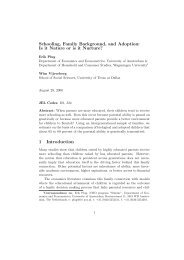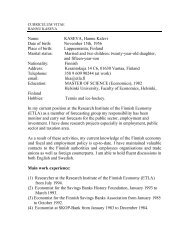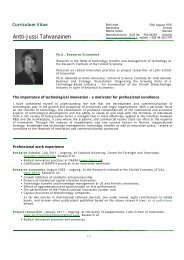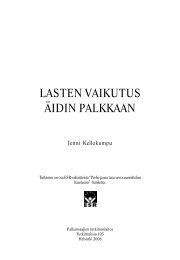Download PDF - Etla
Download PDF - Etla
Download PDF - Etla
You also want an ePaper? Increase the reach of your titles
YUMPU automatically turns print PDFs into web optimized ePapers that Google loves.
14<br />
crucial interdependencies?” This is why management of the R&D‐manufacturing interface is<br />
equally relevant to companies such as Boeing, which designs a new generation of aircraft<br />
only once every 15‐20 years. As one of the interviewees put it: ”If something fails in the new<br />
product introduction process, it is coordination”. Coordination can fail in environments of<br />
both rapid and slow change.<br />
There is overwhelming evidence that with new product generations in particular, product<br />
design and development decisions should not be made without close coordination with<br />
manufacturing. Early involvement of manufacturing in decisions regarding product architecture<br />
and design is essential, as early as the concept development phase. Equally compelling<br />
is the idea that if manufacturing and R&D personnel are not physically co‐located, decisionmaking<br />
and cooperation will not be as efficient. Finally, if R&D is geographically centralized<br />
while manufacturing is decentralized, the new product introduction (NPI) process may be<br />
delayed.<br />
However, to say that co‐location is a necessity would be an oversimplification, for at least<br />
three reasons. First, the benefits of co‐location must be weighed against the losses in efficiency<br />
due to not being able to exploit locational factors to their fullest. Second, while the<br />
dispersion of manufacturing activities is often categorically better than centralization, we<br />
cannot say the same about R&D: a ”critical mass” of R&D activity and personnel is often required<br />
for successful R&D; having small groups of R&D personnel scattered around the<br />
world would not only be very expensive but also likely very unproductive. Third, we again<br />
have to distinguish between different types of interdependence. Specifically, if we look at the<br />
NPI as a process, we observe that the type of interfunctional interdependence varies as a<br />
function of time: at early phases interdependence may be reciprocal, but once the most important<br />
decisions regarding product design are completed, only sequential interdependence<br />
remains, and product developers no longer need manufacturing input to get their work<br />
done. Also, minor changes to existing products can often be performed such that product<br />
development or the product engineers can simply issue an engineering change order to<br />
change the design, knowing that it can readily be implemented in manufacturing.<br />
4.2.1. THE STAGE‐GATE MODEL OF NEW PRODUCT DEVELOPMENT<br />
The majority of electronics companies use some variant of the so‐called stage‐gate (SG)<br />
model to structure their new product development activities. In the model, the NPD process<br />
is structured in a linear fashion around a set of ”stages” (activities such as product architecture<br />
development) and ”gates” at which certain key decisions are made (e.g., detailed design<br />
approval).<br />
There is a time and a place for SG, and the reasons behind this are closely related to the topic<br />
at hand. SG works best when the NPD process can be divided into specific phases that can be<br />
completed in sequence. In essence, it assumes sequential interdependence. Many NPD processes<br />
can be structured in such linear fashion, but others cannot.<br />
SG has been successfully implemented also in environments of high R&D‐manufacturing reciprocal<br />
interdependence. The key insight here is that the SG should not be viewed as a way<br />
of assigning different people to different tasks, but rather, as a way of organizing activities.<br />
To clarify, if the NPD project is handed off to a new group of people at each gate, it will likely
















